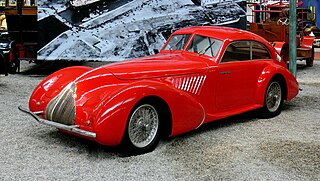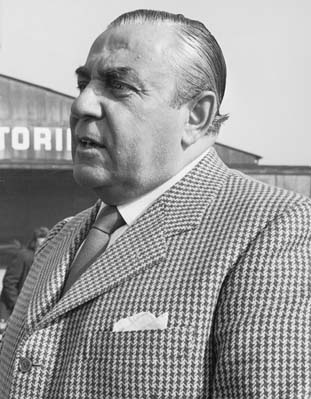
Tazio Giorgio Nuvolari was an Italian racing driver. He first raced motorcycles and then concentrated on sports cars and Grand Prix racing. Originally of Mantua, he was nicknamed il Mantovano Volante and Nuvola ("Cloud"). His victories—72 major races, 150 in all—included 24 Grands Prix, five Coppa Cianos, two Mille Miglias, two Targa Florios, two RAC Tourist Trophies, a Le Mans 24-hour race, and a European Championship in Grand Prix racing. Ferdinand Porsche called him "the greatest driver of the past, the present, and the future".

Abarth & C. S.p.A. is an Italian racing- and road-car maker and performance division founded by Italo-Austrian Carlo Abarth in 1949. Abarth & C. S.p.A. is owned by Stellantis through its Italian subsidiary. Its logo is a shield with a stylized scorpion on a yellow and red background.
Vignale is the luxury car sub-brand of Ford Motor Company used in automobiles sold in Europe. The former company Carrozzeria Alfredo Vignale was an Italian automobile coachbuilder established in 1948 at Via Cigliano, Turin, by Alfredo Vignale (1913–69). After its founder's death in 1969, Carrozzeria Vignale was acquired by De Tomaso. The studio ceased operation in 1973, but ownership of the name was taken over by Ford Motor Company.

Cisitalia was an Italian sports and racing car brand named after "Compagnia Industriale Sportiva Italia", a business conglomerate founded in Turin in 1946 by industrialist and sportsman Piero Dusio. One of the most memorable cars manufactured by the company was the 202 GT from 1946, which earned praise for its design and sold about 170 units.

Piero Dusio was an Italian footballer, businessman, racing driver and racing car manufacturer.

The Alfa Romeo 8C was a range of Alfa Romeo road, race and sports cars of the 1930s.

The automotive industry in Italy is a quite large employer in the country, it had over 2,131 firms and employed almost 250,000 people in 2006. Italy's automotive industry is best known for its automobile designs and small city cars, sports and supercars. The automotive industry makes a contribution of 8.5% to Italian GDP.

Franco Scaglione was an Italian automobile coachwork designer.
Robert Eberan von Eberhorst, later known as Robert Eberan-Eberhorst, was a noted Austrian engineer, who designed the Auto Union Type D Grand Prix motor racing car.

Carlo Abarth, born Karl Albert Abarth, was an Italian automobile designer.

Rudolf Hruska was an Austrian automobile designer and engineer. He was most famous for his design of various Alfa Romeo cars.
The Turin Motor Show is an auto show held annually in Turin, Italy. The first official show took place between 21 and 24 April 1900, at the Castle of Valentino, becoming a permanent fixture in Turin from 1938 having shared it with Milan and Rome until that time. From 1972, the show was held biannually and in 1984, it moved into Fiat's shuttered Lingotto factory.

The Fiat 1800 and 2100 are six-cylinder automobiles produced by Italian manufacturer Fiat between 1959 and 1968. Both models were introduced in 1959. A four-cylinder 1500-cc version, the 1500L, was added to the range in 1963, when the 2100 was replaced by the larger engined 2300. The 1800/2100 were designed by Fiat's own Dante Giacosa.

Aldo Brovarone was an Italian automobile designer and the chief stylist with Carrozzeria Pininfarina (1974-1988) – widely known for a prominent range of work including the Dino 206 GT, Lancia Gamma Coupé and the Peugeot 504 (sedan).

Maggiora was an Italian coachbuilder and parts supplier from Moncalieri near Turin. They produced the Fiat Barchetta and the Lancia Kappa Coupé which was designed by Centro Stile Lancia. The company was shut down in 2003.

The Fiat-Abarth 750 is a compact sporting series of automobiles manufactured by the Italian manufacturing firm Abarth & C. of Turin, Italy in the 1950s and 1960s. The cars used the floorpan and often the bodywork of the Fiat 600 but were fitted with Abarth's modified engines. Abarth also offered a number of bodyworks by other designers for the 750 and its derivatives, most famously Zagato but also Allemano and others.

The Abarth 205A Berlinetta was a coupé sports car, also known as the Abarth 205A Monza built by Austrian born tuning expert Carlo Abarth in 1950. It was a development of the Abarth Cisitalia 204A but with a new platform chassis, still using the engine and other components from the Fiat 1100 B/E. Only three 205As were finished in 1950; chassis numbers 101, 102, and 103, but an additional car was built in 1953 with an extravagant Ghia body. Slow sales meant that for the next few years Abarth chose to focus on building his exhaust and tuning business, allowing competition and car manufacturing take a backseat. In 1955, the 205A was succeeded by the 207A Spyder and its derivatives.

Giovanni Savonuzzi was an Italian automobile designer who was born and died in Ferrara.
The Autolook Week is an annual motorsport festival held for the first time in Turin from 7 to 11 September 2022.

The Abarth 207A Boano Spyder is a competition car created by Abarth & C. with the aim of selling in the United States market. It succeeded the earlier Abarth 205A Berlinetta and continued to use the Fiat 1100's four-cylinder engine. It also continued to use the naming practice started with the Cisitalia 202 and 204, which continued with the Abarth 204A and 205A. Design work started in 1954 and the car was first presented at the 1955 Turin Motor Show. A street-oriented version of the Spyder called the 208A, fitted with a panoramic windshield, was shown in 1954, as well as a Coupé model with an airy glasshouse, called the 209A. Both of the street versions appear to have remained one-offs.

















